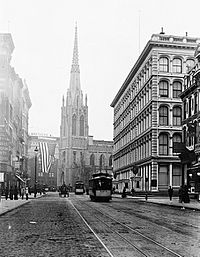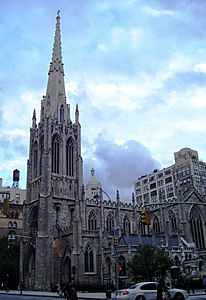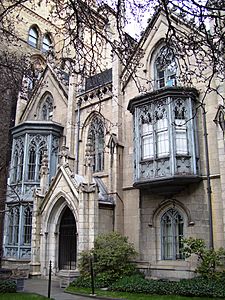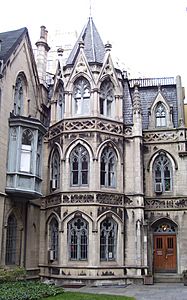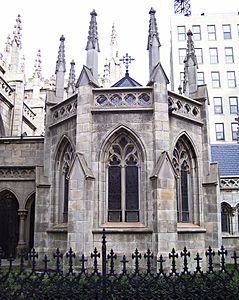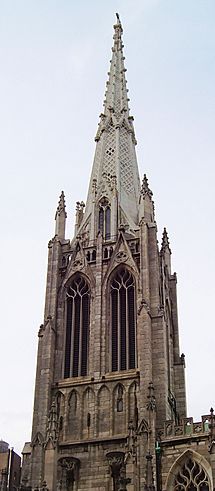Grace Church (Manhattan) facts for kids
Quick facts for kids Grace Church |
|
|---|---|
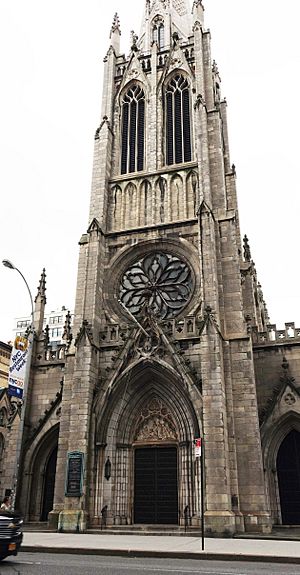 |
|
| Lua error in Module:Location_map at line 420: attempt to index field 'wikibase' (a nil value). | |
| Location | 800–804 Broadway Manhattan (NYC), New York |
| Country | United States |
| Denomination | Episcopal Church |
| Churchmanship | Broad Church |
| History | |
| Status | Parish church |
| Architecture | |
| Functional status | Active |
| Years built | 1846–1847 |
| Specifications | |
| Number of spires | 1 |
| Spire height | 230 feet (70 m) |
| Materials | Sing Sing marble exterior; lath and plaster interior |
| Administration | |
| Diocese | Episcopal Diocese of New York |
| Province | Province II |
Grace Church is a very old and important church in New York City. It's part of the Episcopal Church in New York. You can find it at 800–804 Broadway, right where Broadway meets East 10th Street.
The church is known as "one of the city's greatest treasures." It was designed by James Renwick Jr. in a beautiful French Gothic Revival style. Grace Church is so special that it's a National Historic Landmark. This means it's recognized for its amazing architecture and its role in New York City's history. The whole church area is also a New York City landmark.
Contents
Grace Church: A Look at Its History and Design
Grace Church first started in 1808 on Broadway and Rector Street. In 1834, the church decided to move uptown because New York City was growing. They bought the land for the new church in 1843.
A young architect named James Renwick Jr., who was only 25 at the time, was chosen to design the new church. This was his first big project!
Building the Church
The first stone for the new church was laid in 1843. The church was officially ready in 1846. Grace Church was built in the French Gothic Revival style. It's made from Sing Sing marble. Records show that workers from Sing Sing state prison helped cut the stone.
The church first had a wooden spire (the tall, pointy part of the roof). But in 1881, it was replaced with a marble spire, also designed by Renwick. The inside of the church is mostly made from lath and plaster.
Inside the Church
The large window above the main altar is very impressive. It was made in 1878 by an English company called Clayton and Bell. This "Te Deum" window shows figures looking up at Christ, representing prophets, apostles, and people from all over the world. Other windows in the church were made by Henry Holiday.
The reredos (a decorated screen behind the altar) is made of French and Italian marble. It shows the four Gospel writers: Matthew, Mark, Luke, and John. They are shown with the Risen Christ. This piece was also designed by Renwick in 1878.
For many years after it was built, Grace Church was a very popular place in New York. People thought it was very special to get married or have a funeral there.
|
|
Buildings and Architects Over Time
Many different buildings and changes have been made to the Grace Church complex over the years. Here's a timeline:
| Date | Building or action | Architect |
|---|---|---|
| 1843–1846 | Main church building (800 Broadway) | James Renwick Jr. |
| 1846–1847 | Rectory (804 Broadway) | James Renwick Jr. |
| 1878–1879 | Chantry | Edward T. Potter |
| 1880–1881 | Grace House (802 Broadway) | James Renwick Jr. |
| 1881 | Front garden | Vaux & Co. |
| 1881–1882 | Memorial House (92–96 Fourth Avenue) | James Renwick Jr. |
| 1883 | New marble spire | James Renwick Jr. |
| 1902–1903 | Clergy House (90 Fourth Avenue) | Heins & LaFarge |
| 1903 | Chancel extension | Heins & LaFarge |
| 1906–1907 | Neighborhood House (98 Fourth Avenue) | Renwick, Aspinwall & Tucker |
| 1910 | Chantry additions | William W. Renwick |
| 1975–1976 | Addition to church houses for school | |
| 2003 | Spire repair | Walter B. Melvin Architects |
Grace Church School
Grace Church School started in 1894. It was originally a place where choir boys could get special training. In 1934, it became a day school. Today, the school teaches boys and girls from pre-kindergarten all the way to twelfth grade.
The school is located at 86 Fourth Avenue and uses several church buildings. In 2006, the school became a separate organization from the church. The high school building for Grace Church School opened in 2011 in Cooper Square.
Services and Community Programs
Grace Church holds many prayer and Eucharist (communion) services throughout the week. They also host special events like weddings and baptisms.
The church has a long history of helping its community. It's believed that Grace Church had the first day-care center in New York City! Today, the church offers many services. These include a community outreach program and spiritual education classes for both adults and kids. There's even a shelter for homeless men in one of the church's buildings on Fourth Avenue.
Grace Church is also famous for its Choir of Men and Boys, which began in 1894. They have a rich music program, including regular organ concerts.
Notable Leaders of Grace Church
Over the years, many important people have led Grace Church:
- Jonathan Mayhew Wainwright (third rector) – He helped start new churches across New York state. He also created schools for girls and boys in 1823.
- Thomas House Taylor (fourth rector) – He was the leader when the church moved to its current location.
- Henry Codman Potter (fifth rector) – He believed in the "Social Gospel," which meant helping the poor and immigrant communities. He later became the Bishop of New York.
- William Reed Huntington (sixth rector) – He was known as "the First Presbyter of the Episcopal Church." He worked on updating the Book of Common Prayer and expanded the church's buildings. He also continued the church's social work.
- Charles Lewis Slattery (seventh rector) – He led the group that published the 1928 Book of Common Prayer.
- Walter Russell Bowie (eighth rector) – He was a scholar and writer. He helped create the Revised Standard Version (RSV) of the Bible.
- C. FitzSimons Allison (eleventh rector) – He later became the Bishop of South Carolina.
Current Clergy
- The Reverend J. Donald Waring, Rector (the main leader)
- The Reverend Chase Danford, Associate Rector
- The Reverend Julia Offinger, Assistant Rector for Youth and Family Ministry
- Dr. Patrick Allen, Organist and Master of Choristers
Famous Weddings at Grace Church
Grace Church has been the setting for some notable weddings:
- Consuelo Yznaga (who was the godmother of Consuelo Vanderbilt) married George Montagu, who was then Viscount Mandeville, on May 22, 1876.
- Cornelia Martin married William Craven, 4th Earl of Craven on April 18, 1893.
See also
 In Spanish: Iglesia de Gracia y Dependencias para niños
In Spanish: Iglesia de Gracia y Dependencias para niños


